Deck 25: Capital Budgeting and Managerial Decisions
Question
Question
Question
Question
Question
Question
Question
Question
Question
Question
Question
Question
Question
Question
Question
Question
Question
Question
Question
Question
Question
Question
Question
Question
Question
Question
Question
Question
Question
Question
Question
Question
Question
Question
Question
Question
Question
Question
Question
Question
Question
Question
Question
Question
Question
Question
Question
Question
Question
Question
Question
Question
Question
Question
Question
Question
Question
Question
Question
Question
Question
Question
Question
Question
Question
Question
Question
Question
Question
Question
Question
Question
Question
Question
Question
Question
Question
Question
Question
Question

Unlock Deck
Sign up to unlock the cards in this deck!
Unlock Deck
Unlock Deck
1/91
Play
Full screen (f)
Deck 25: Capital Budgeting and Managerial Decisions
1
Aikman Company has an opportunity to invest in one of two projects. Project A requires a $240,000 investment for new machinery with a four-year life and no salvage value. Project B also requires a $240,000 investment for new machinery with a three-year life and no salvage value. The two projects yield the following predicted annual results. The company uses straight-line depreciation, and cash flows occur evenly throughout each year.
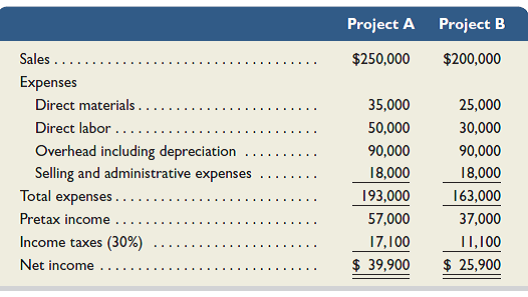
Required
1. Compute each project's annual expected net cash flows. (Round net cash flows to the nearest dollar.)
2. Determine each project's payback period. (Round the payback period to two decimals.)
3. Compute each project's accounting rate of return. (Round the percentage return to one decimal.)
4. Determine each project's net present value using 8% as the discount rate. For part 4 only, assume that cash flows occur at each year-end. (Round net present values to the nearest dollar.)
Analysis Component
5. Identify the project you would recommend to management and explain your choice.

Required
1. Compute each project's annual expected net cash flows. (Round net cash flows to the nearest dollar.)
2. Determine each project's payback period. (Round the payback period to two decimals.)
3. Compute each project's accounting rate of return. (Round the percentage return to one decimal.)
4. Determine each project's net present value using 8% as the discount rate. For part 4 only, assume that cash flows occur at each year-end. (Round net present values to the nearest dollar.)
Analysis Component
5. Identify the project you would recommend to management and explain your choice.
Project A:
It requires a $240,000 investment for new machinery with a four year life and no salvage value.
Project B:
It requires a $240,000 investment for new machinery with a three year life and no salvage value.
Straight-line method can be used to calculate the annual depreciation for both the projects.
1).
Calculate Expected annual net cash flows:
Annual net cash flows can be calculated using the following formula;
 Depreciation can be calculated using the straight-line method as follows;
Depreciation can be calculated using the straight-line method as follows;


 Calculate Expected annual net cash flows:
Calculate Expected annual net cash flows:
 2).
2).
Calculate Payback period:
Payback period can be calculated using the following formula;

 3).
3).
Calculate Accounting rate of return:
Accounting rate of return can be calculated using the following formula;
 Annual average investment can be calculated as follows;
Annual average investment can be calculated as follows;

 Calculate Accounting rate of return:
Calculate Accounting rate of return:
 4).
4).
Calculate Net present value:
Net present value can be calculated using the below formula;
 Project A:
Project A:
 Project B:
Project B:
 5). Analysis component:
5). Analysis component:
Project A is more profitable than the project B, since the net present value and the accounting rate of return for the concern are higher than the other project. May be the payback period is a little bit longer than the other project (Z), it will have another 1.2 year for the cash inflows. So the project A is more preferable than the project B.
It requires a $240,000 investment for new machinery with a four year life and no salvage value.
Project B:
It requires a $240,000 investment for new machinery with a three year life and no salvage value.
Straight-line method can be used to calculate the annual depreciation for both the projects.
1).
Calculate Expected annual net cash flows:
Annual net cash flows can be calculated using the following formula;
 Depreciation can be calculated using the straight-line method as follows;
Depreciation can be calculated using the straight-line method as follows;

 Calculate Expected annual net cash flows:
Calculate Expected annual net cash flows:  2).
2). Calculate Payback period:
Payback period can be calculated using the following formula;

 3).
3). Calculate Accounting rate of return:
Accounting rate of return can be calculated using the following formula;
 Annual average investment can be calculated as follows;
Annual average investment can be calculated as follows;
 Calculate Accounting rate of return:
Calculate Accounting rate of return:  4).
4). Calculate Net present value:
Net present value can be calculated using the below formula;
 Project A:
Project A:  Project B:
Project B:  5). Analysis component:
5). Analysis component: Project A is more profitable than the project B, since the net present value and the accounting rate of return for the concern are higher than the other project. May be the payback period is a little bit longer than the other project (Z), it will have another 1.2 year for the cash inflows. So the project A is more preferable than the project B.
2
Compute the payback period for each of these two separate investments (round the payback period to two decimals):
a. A new operating system for an existing machine is expected to cost $520,000 and have a useful life of six years. The system yields an incremental after-tax income of $150,000 each year after deducting its straight-line depreciation. The predicted salvage value of the system is $10,000.
b. A machine costs $380,000, has a $20,000 salvage value, is expected to last eight years, and will generate an after-tax income of $60,000 per year after straight-line depreciation.
a. A new operating system for an existing machine is expected to cost $520,000 and have a useful life of six years. The system yields an incremental after-tax income of $150,000 each year after deducting its straight-line depreciation. The predicted salvage value of the system is $10,000.
b. A machine costs $380,000, has a $20,000 salvage value, is expected to last eight years, and will generate an after-tax income of $60,000 per year after straight-line depreciation.
a.
Payback period:
• Payback period means the time period to get back the investment made in a project inform of returns. This is one of the most familiar techniques to compare investment alternatives.
• Generally, companies are interested in the projects having the shorter payback period because once the funds invested in the project were got back then the funds can be used for some other purpose which helps for the organization growth and development.
• In this method cash flows beyond payback period are not considered. Payback period can be calculated by using following formula:
 Where, 'annual net cash flows' are the expected cash inflows after deducting expected cash outflows. While computing net cash flows non cash revenues and expenses are to be excluded.
Where, 'annual net cash flows' are the expected cash inflows after deducting expected cash outflows. While computing net cash flows non cash revenues and expenses are to be excluded.
It is given that the new operating system for an existing machine costs $ 520,000. The useful life of the system is 6 years and the salvage value is $10,000. The net income after taxes and depreciation is $150,000 each year.
Calculate depreciation :
 Where,
Where,

 Therefore, Payback period is 2.21 years.
Therefore, Payback period is 2.21 years.
b.
It is given that the machine costs $380,000. The useful life of the machine is 8 years and the salvage value is $20,000. The net income after taxes and depreciation is $60,000 each year.
Calculate depreciation :
 We know that
We know that
 Where,
Where,

 Therefore, Payback period is 3.62 years.
Therefore, Payback period is 3.62 years.
Payback period:
• Payback period means the time period to get back the investment made in a project inform of returns. This is one of the most familiar techniques to compare investment alternatives.
• Generally, companies are interested in the projects having the shorter payback period because once the funds invested in the project were got back then the funds can be used for some other purpose which helps for the organization growth and development.
• In this method cash flows beyond payback period are not considered. Payback period can be calculated by using following formula:
 Where, 'annual net cash flows' are the expected cash inflows after deducting expected cash outflows. While computing net cash flows non cash revenues and expenses are to be excluded.
Where, 'annual net cash flows' are the expected cash inflows after deducting expected cash outflows. While computing net cash flows non cash revenues and expenses are to be excluded.It is given that the new operating system for an existing machine costs $ 520,000. The useful life of the system is 6 years and the salvage value is $10,000. The net income after taxes and depreciation is $150,000 each year.
Calculate depreciation :
 Where,
Where,
 Therefore, Payback period is 2.21 years.
Therefore, Payback period is 2.21 years. b.
It is given that the machine costs $380,000. The useful life of the machine is 8 years and the salvage value is $20,000. The net income after taxes and depreciation is $60,000 each year.
Calculate depreciation :
 We know that
We know that Where,
Where,
 Therefore, Payback period is 3.62 years.
Therefore, Payback period is 3.62 years. 3
B2B Co. is considering the purchase of equipment that would allow the company to add a new product to its line. The equipment is expected to cost $360,000 with a six-year life and no salvage value. It will be depreciated on a straight-line basis. The company expects to sell 144,000 units of the equipment's product each year. The expected annual income related to this equipment follows. Compute the (1) payback period and (2) accounting rate of return for this equipment.
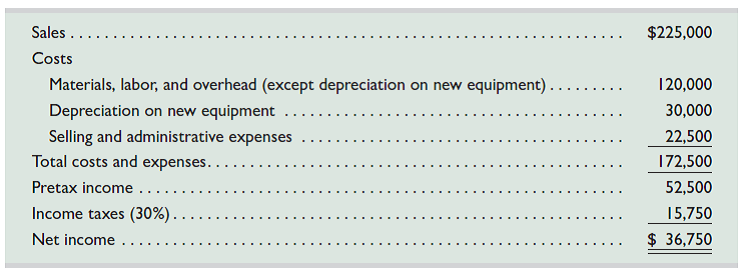

1.
Payback Period
A method that helps to identify the time taken by the investment to cover the cost is known as pay back period. The pay back period method ignores the profitability of the investment and the time value of the money.
The project having an early payback period is preferred over the project having late payback period.
Calculate the payback period as follows:
 Hence, the payback period is 5.39 years.
Hence, the payback period is 5.39 years.
Working note:
Calculate the amount of annual net cash flow as follows:
 Accounting rate of return is the relationship between average accounting profits after tax and investment in the project. It is a ratio which considers the profit from a project in relation to the investment in the project.It is calculated in terms of percentage.
Accounting rate of return is the relationship between average accounting profits after tax and investment in the project. It is a ratio which considers the profit from a project in relation to the investment in the project.It is calculated in terms of percentage.
Formula to calculate the Accounting rate of return:
 If a company uses straight line depreciation method, find average amount invested by using the given formula.
If a company uses straight line depreciation method, find average amount invested by using the given formula.

 The accounting return is called return on average investment and it is computed by dividing a project after tax net income by the average amount invested in it.
The accounting return is called return on average investment and it is computed by dividing a project after tax net income by the average amount invested in it.
Compute the Accounting rate of return as follows:
 Hence, the Accounting rate of return is 20.41%.
Hence, the Accounting rate of return is 20.41%.
Payback Period
A method that helps to identify the time taken by the investment to cover the cost is known as pay back period. The pay back period method ignores the profitability of the investment and the time value of the money.
The project having an early payback period is preferred over the project having late payback period.
Calculate the payback period as follows:
 Hence, the payback period is 5.39 years.
Hence, the payback period is 5.39 years. Working note:
Calculate the amount of annual net cash flow as follows:
 Accounting rate of return is the relationship between average accounting profits after tax and investment in the project. It is a ratio which considers the profit from a project in relation to the investment in the project.It is calculated in terms of percentage.
Accounting rate of return is the relationship between average accounting profits after tax and investment in the project. It is a ratio which considers the profit from a project in relation to the investment in the project.It is calculated in terms of percentage. Formula to calculate the Accounting rate of return:
 If a company uses straight line depreciation method, find average amount invested by using the given formula.
If a company uses straight line depreciation method, find average amount invested by using the given formula.
 The accounting return is called return on average investment and it is computed by dividing a project after tax net income by the average amount invested in it.
The accounting return is called return on average investment and it is computed by dividing a project after tax net income by the average amount invested in it.Compute the Accounting rate of return as follows:
 Hence, the Accounting rate of return is 20.41%.
Hence, the Accounting rate of return is 20.41%. 4
Refer to the information in Exercise 25-11. Create an Excel spreadsheet to compute the internal rate of return for each of the projects. Based on internal rate of return, determine whether the company should accept either of the two projects.
Reference: Exercise 25-11
Following is information on two alternative investments being considered by Tiger Co. The company requires a 4% return from its investments.

Compute each project's (a) net present value and (b) profitability index. (Round present value calculations to the nearest dollar and round the profitability index to two decimal places.) If the company can choose only one project, which should it choose Explain.
Reference: Exercise 25-11
Following is information on two alternative investments being considered by Tiger Co. The company requires a 4% return from its investments.

Compute each project's (a) net present value and (b) profitability index. (Round present value calculations to the nearest dollar and round the profitability index to two decimal places.) If the company can choose only one project, which should it choose Explain.

Unlock Deck
Unlock for access to all 91 flashcards in this deck.
Unlock Deck
k this deck
5
Gelb Company currently manufactures 40,000 units per year of a key component for its manufacturing process. Variable costs are $1.95 per unit, fixed costs related to making this component are $65,000 per year, and allocated fixed costs are $58,500 per year. The allocated fixed costs are unavoidable whether the company makes or buys this component. The company is considering buying this component from a supplier for $3.50 per unit. Should it continue to manufacture the component, or should it buy this component from the outside supplier Support your decision with analysis of the data provided.

Unlock Deck
Unlock for access to all 91 flashcards in this deck.
Unlock Deck
k this deck
6
Park Co. is considering an investment that requires immediate payment of $27,000 and provides expected cash inflows of $9,000 annually for four years. If Park Co. requires a 10% return on its investments, what is the net present value of this investment (Round your calculations to the nearest dollar.)

Unlock Deck
Unlock for access to all 91 flashcards in this deck.
Unlock Deck
k this deck
7
Edgerron Company is able to produce two products, G and B, with the same machine in its factory. The following information is available.

The company presently operates the machine for a single eight-hour shift for 22 working days each month. Management is thinking about operating the machine for two shifts, which will increase its productivity by another eight hours per day for 22 days per month. This change would require $15,000 additional fixed costs per month.
Required
1. Determine the contribution margin per machine hour that each product generates.
2. How many units of Product G and Product B should the company produce if it continues to operate with only one shift How much total contribution margin does this mix produce each month
3. If the company adds another shift, how many units of Product G and Product B should it produce How much total contribution margin would this mix produce each month Should the company add the new shift Explain.
4. Suppose that the company determines that it can increase Product G's maximum sales to 700 units per month by spending $12,000 per month in marketing efforts. Should the company pursue this strategy and the double shift Explain.

The company presently operates the machine for a single eight-hour shift for 22 working days each month. Management is thinking about operating the machine for two shifts, which will increase its productivity by another eight hours per day for 22 days per month. This change would require $15,000 additional fixed costs per month.
Required
1. Determine the contribution margin per machine hour that each product generates.
2. How many units of Product G and Product B should the company produce if it continues to operate with only one shift How much total contribution margin does this mix produce each month
3. If the company adds another shift, how many units of Product G and Product B should it produce How much total contribution margin would this mix produce each month Should the company add the new shift Explain.
4. Suppose that the company determines that it can increase Product G's maximum sales to 700 units per month by spending $12,000 per month in marketing efforts. Should the company pursue this strategy and the double shift Explain.

Unlock Deck
Unlock for access to all 91 flashcards in this deck.
Unlock Deck
k this deck
8
Peng Company is considering an investment expected to generate an average net income after taxes of $1,950 for three years. The investment costs $45,000 and has an estimated $6,000 salvage value. Assume Peng requires a 15% return on its investments. Compute the net present value of this investment. (Round each present value calculation to the nearest dollar.)

Unlock Deck
Unlock for access to all 91 flashcards in this deck.
Unlock Deck
k this deck
9
A company is considering investing in a new machine that requires a cash payment of $47,947 today. The machine will generate annual cash flows of $21,000 for the next three years. What is the internal rate of return if the company buys this machine

Unlock Deck
Unlock for access to all 91 flashcards in this deck.
Unlock Deck
k this deck
10
Holmes Company produces a product that can either be sold as is or processed further. Holmes has already spent $50,000 to produce 1,250 units that can be sold now for $67,500 to another manufacturer. Alternatively, Holmes can process the units further at an incremental cost of $250 per unit. If Holmes processes further, the units can be sold for $375 each. Compute the incremental income if Holmes processes further.

Unlock Deck
Unlock for access to all 91 flashcards in this deck.
Unlock Deck
k this deck
11
A consultant commented that "too often the numbers look good but feel bad." This comment often stems from estimation error common to capital budgeting proposals that relate to future cash flows. Three reasons for this error often exist. First, reliably predicting cash flows several years into the future is very difficult. Second, the present value of cash flows many years into the future (say, beyond 10 years) is often very small. Third, it is difficult for personal biases and expectations not to unduly influence present value computations.
Required
1. Compute the present value of $100 to be received in 10 years assuming a 12% discount rate.
2. Why is understanding the three reasons mentioned for estimation errors important when evaluating investment projects Link this response to your answer for part 1.
Required
1. Compute the present value of $100 to be received in 10 years assuming a 12% discount rate.
2. Why is understanding the three reasons mentioned for estimation errors important when evaluating investment projects Link this response to your answer for part 1.

Unlock Deck
Unlock for access to all 91 flashcards in this deck.
Unlock Deck
k this deck
12
Sung Company is able to produce two products, R and T, with the same machine in its factory. The following information is available.

Required
1. Determine the contribution margin per machine hour that each product generates.
2. How many units of Product R and Product T should the company produce if it continues to operate with only one shift How much total contribution margin does this mix produce each month
3. If the company adds another shift, how many units of Product R and Product T should it produce How much total contribution margin would this mix produce each month Should the company add the new shift Explain.
4. Suppose that the company determines that it can increase Product R's maximum sales to 675 units per month by spending $4,500 per month in marketing efforts. Should the company pursue this strategy and the double shift Explain.

Required
1. Determine the contribution margin per machine hour that each product generates.
2. How many units of Product R and Product T should the company produce if it continues to operate with only one shift How much total contribution margin does this mix produce each month
3. If the company adds another shift, how many units of Product R and Product T should it produce How much total contribution margin would this mix produce each month Should the company add the new shift Explain.
4. Suppose that the company determines that it can increase Product R's maximum sales to 675 units per month by spending $4,500 per month in marketing efforts. Should the company pursue this strategy and the double shift Explain.

Unlock Deck
Unlock for access to all 91 flashcards in this deck.
Unlock Deck
k this deck
13
Access Samsung 's 2013 Corporate Sustainability Report, from its website www.samsung.com. Identify and read the section "Social Responsibility: Making Contributions Around the Globe."
Required
Samsung's 2013 Corporate Sustainability Report notes that the company spent 245 billion Korean won in 2012 for programs devoted to better health and education for children. Why would a company like Samsung pursue such a costly program
Required
Samsung's 2013 Corporate Sustainability Report notes that the company spent 245 billion Korean won in 2012 for programs devoted to better health and education for children. Why would a company like Samsung pursue such a costly program

Unlock Deck
Unlock for access to all 91 flashcards in this deck.
Unlock Deck
k this deck
14
 Apple is considering expanding a store. Identify three methods management can use to evaluate whether to expand.
Apple is considering expanding a store. Identify three methods management can use to evaluate whether to expand.

Unlock Deck
Unlock for access to all 91 flashcards in this deck.
Unlock Deck
k this deck
15
A company must decide between scrapping or reworking units that do not pass inspection. The company has 22,000 defective units that cost $6 per unit to manufacture. The units can be sold as is for $2.50 each, or they can be reworked for $4.50 each and then sold for the full price of $8.50 each. If the units are sold as is, the company will be able to build 22,000 replacement units at a cost of $6 each, and sell them at the full price of $8.50 each. (1) What is the incremental income from selling the units as scrap (2) What is the incremental income from reworking and selling the units (3) Should the company sell the units as scrap or rework them

Unlock Deck
Unlock for access to all 91 flashcards in this deck.
Unlock Deck
k this deck
16
 Identify four reasons that capital budgeting decisions by managers are risky.
Identify four reasons that capital budgeting decisions by managers are risky.
Unlock Deck
Unlock for access to all 91 flashcards in this deck.
Unlock Deck
k this deck
17
Project A requires a $280,000 initial investment for new machinery with a five-year life and a salvage value of $30,000. The company uses straight-line depreciation. Project A is expected to yield annual net income of $20,000 per year for the next five years. Compute Project A's payback period.

Unlock Deck
Unlock for access to all 91 flashcards in this deck.
Unlock Deck
k this deck
18
 If a potential investment's internal rate of return is above the company's hurdle rate, should the investment be made
If a potential investment's internal rate of return is above the company's hurdle rate, should the investment be made
Unlock Deck
Unlock for access to all 91 flashcards in this deck.
Unlock Deck
k this deck
19
Phoenix Company can invest in each of three cheese-making projects: C1, C2, and C3. Each project requires an initial investment of $228,000 and would yield the following annual cash flows.

(1) Assuming that the company requires a 12% return from its investments, use net present value to determine which projects, if any, should be acquired. (2) Using the answer from part 1, explain whether the internal rate of return is higher or lower than 12% for Project C2.

(1) Assuming that the company requires a 12% return from its investments, use net present value to determine which projects, if any, should be acquired. (2) Using the answer from part 1, explain whether the internal rate of return is higher or lower than 12% for Project C2.

Unlock Deck
Unlock for access to all 91 flashcards in this deck.
Unlock Deck
k this deck
20
A company has already incurred $5,000 of costs in producing 6,000 units of Product XY. Product XY can be sold as is for $15 per unit. Instead, the company could incur further processing costs of $8 per unit and sell the resulting product for $21 per unit. Should the company sell Product XY as is or process it further

Unlock Deck
Unlock for access to all 91 flashcards in this deck.
Unlock Deck
k this deck
21
A machine can be purchased for $150,000 and used for five years, yielding the following net incomes. In projecting net incomes, straight-line depreciation is applied, using a five-year life and a zero salvage value. Compute the machine's payback period (ignore taxes). (Round the payback period to three decimals.)



Unlock Deck
Unlock for access to all 91 flashcards in this deck.
Unlock Deck
k this deck
22
Break into teams and identify four reasons that an international airline such as Southwest or Delta would invest in a project when its direct analysis using both payback period and net present value indicate it to be a poor investment. ( Hint: Think about qualitative factors.) Provide an example of an investment project that supports your answer.

Unlock Deck
Unlock for access to all 91 flashcards in this deck.
Unlock Deck
k this deck
23
After evaluating the risk of the investment described in Exercise 25-8, B2B Co. concludes that it must earn at least an 8% return on this investment. Compute the net present value of this investment. (Round the net present value to the nearest dollar.)
Reference: Exercise 25-8
B2B Co. is considering the purchase of equipment that would allow the company to add a new product to its line. The equipment is expected to cost $360,000 with a six-year life and no salvage value. It will be depreciated on a straight-line basis. The company expects to sell 144,000 units of the equipment's product each year. The expected annual income related to this equipment follows. Compute the (1) payback period and (2) accounting rate of return for this equipment.

Reference: Exercise 25-8
B2B Co. is considering the purchase of equipment that would allow the company to add a new product to its line. The equipment is expected to cost $360,000 with a six-year life and no salvage value. It will be depreciated on a straight-line basis. The company expects to sell 144,000 units of the equipment's product each year. The expected annual income related to this equipment follows. Compute the (1) payback period and (2) accounting rate of return for this equipment.


Unlock Deck
Unlock for access to all 91 flashcards in this deck.
Unlock Deck
k this deck
24
A company is considering investing in a new machine that requires a cash payment of $47,947 today. The machine will generate annual cash flows of $21,000 for the next three years. Assume the company uses an 8% discount rate. Compute the net present value of this investment. (Round your answer to the nearest dollar.)

Unlock Deck
Unlock for access to all 91 flashcards in this deck.
Unlock Deck
k this deck
25
Varto Company has 7,000 units of its sole product in inventory that it produced last year at a cost of $22 each. This year's model is superior to last year's and the 7,000 units cannot be sold at last year's regular selling price of $35 each. Varto has two alternatives for these items: (1) they can be sold to a wholesaler for $8 each, or (2) they can be reworked at a cost of $125,000 and then sold for $25 each. Prepare an analysis to determine whether Varto should sell the products as is or rework them and then sell them.

Unlock Deck
Unlock for access to all 91 flashcards in this deck.
Unlock Deck
k this deck
26
Manning Corporation is considering a new project requiring a $90,000 investment in test equipment with no salvage value. The project would produce $66,000 of pretax income before depreciation at the end of each of the next six years. The company's income tax rate is 40%. In compiling its tax return and computing its income tax payments, the company can choose between the two alternative depreciation schedules shown in the table.
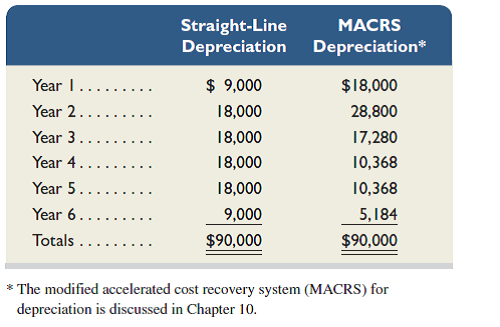
Required
1. Prepare a five-column table that reports amounts (assuming use of straight-line depreciation) for each of the following for each of the six years: (a) pretax income before depreciation, (b) straight-line depreciation expense, (c) taxable income, (d) income taxes, and (e) net cash flow. Net cash flow equals the amount of income before depreciation minus the income taxes. (Round answers to the nearest dollar.)
2. Prepare a five-column table that reports amounts (assuming use of MACRS depreciation) for each of the following for each of the six years: (a) pretax income before depreciation, (b) MACRS depreciation expense, (c) taxable income, (d) income taxes, and (e) net cash flow. Net cash flow equals the income amount before depreciation minus the income taxes. (Round answers to the nearest dollar.)
3. Compute the net present value of the investment if straight-line depreciation is used. Use 10% as the discount rate. (Round the net present value to the nearest dollar.)
4. Compute the net present value of the investment if MACRS depreciation is used. Use 10% as the discount rate. (Round the net present value to the nearest dollar.)
Analysis Component
5. Explain why the MACRS depreciation method increases this project's net present value.

Required
1. Prepare a five-column table that reports amounts (assuming use of straight-line depreciation) for each of the following for each of the six years: (a) pretax income before depreciation, (b) straight-line depreciation expense, (c) taxable income, (d) income taxes, and (e) net cash flow. Net cash flow equals the amount of income before depreciation minus the income taxes. (Round answers to the nearest dollar.)
2. Prepare a five-column table that reports amounts (assuming use of MACRS depreciation) for each of the following for each of the six years: (a) pretax income before depreciation, (b) MACRS depreciation expense, (c) taxable income, (d) income taxes, and (e) net cash flow. Net cash flow equals the income amount before depreciation minus the income taxes. (Round answers to the nearest dollar.)
3. Compute the net present value of the investment if straight-line depreciation is used. Use 10% as the discount rate. (Round the net present value to the nearest dollar.)
4. Compute the net present value of the investment if MACRS depreciation is used. Use 10% as the discount rate. (Round the net present value to the nearest dollar.)
Analysis Component
5. Explain why the MACRS depreciation method increases this project's net present value.

Unlock Deck
Unlock for access to all 91 flashcards in this deck.
Unlock Deck
k this deck
27
What is the average amount invested in a machine during its predicted five-year life if it costs $200,000 and has a $20,000 salvage value Assume that net income is received evenly throughout each year and straight-line depreciation is used.

Unlock Deck
Unlock for access to all 91 flashcards in this deck.
Unlock Deck
k this deck
28
If Quail Company invests $50,000 today, it can expect to receive $10,000 at the end of each year for the next seven years, plus an extra $6,000 at the end of the seventh year. What is the net present value of this investment assuming a required 10% return on investments (Round present value calculations to the nearest dollar.)

Unlock Deck
Unlock for access to all 91 flashcards in this deck.
Unlock Deck
k this deck
29
 Assume that Samsung manufactures and sells 60,000 units of a product at $11,000 per unit in domestic markets. It costs $6,000 per unit to manufacture ($4,000 variable cost per unit, $2,000 fixed cost per unit). Can you describe a situation under which the company is willing to sell an additional 8,000 units of the product in an international market at $5,000 per unit
Assume that Samsung manufactures and sells 60,000 units of a product at $11,000 per unit in domestic markets. It costs $6,000 per unit to manufacture ($4,000 variable cost per unit, $2,000 fixed cost per unit). Can you describe a situation under which the company is willing to sell an additional 8,000 units of the product in an international market at $5,000 per unit 

Unlock Deck
Unlock for access to all 91 flashcards in this deck.
Unlock Deck
k this deck
30
Excel Memory Company can sell all units of computer memory X and Y that it can produce, but it has limited production capacity. It can produce two units of X per hour or three units of Y per hour, and it has 4,000 production hours available. Contribution margin is $5 for Product X and $4 for Product Y. What is the most profitable sales mix for this company

Unlock Deck
Unlock for access to all 91 flashcards in this deck.
Unlock Deck
k this deck
31
Assume Apple invested $2.12 billion to expand its manufacturing capacity. Assume that these assets have a 10-year life, and that Apple requires a 10% internal rate of return on these assets.
Required
1. What is the amount of annual cash flows that Apple must earn from these projects to have a 10% internal rate of return ( Hint: Identify the 10-period, 10% factor from the present value of an annuity table, and then divide $2.12 billion by this factor to get the annual cash flows necessary.)
Fast Forward
2. Access Apple's financial statements for fiscal years ended after September 28, 2013, from its website ( Apple.com ) or the SEC's website ( SEC.gov ).
a. Determine the amount that Apple invested in capital assets for the most recent year. ( Hint: Refer to the statement of cash flows.)
b. Assume a 10-year life and a 10% internal rate of return. What is the amount of cash flows that Apple must earn on these new projects
Required
1. What is the amount of annual cash flows that Apple must earn from these projects to have a 10% internal rate of return ( Hint: Identify the 10-period, 10% factor from the present value of an annuity table, and then divide $2.12 billion by this factor to get the annual cash flows necessary.)
Fast Forward
2. Access Apple's financial statements for fiscal years ended after September 28, 2013, from its website ( Apple.com ) or the SEC's website ( SEC.gov ).
a. Determine the amount that Apple invested in capital assets for the most recent year. ( Hint: Refer to the statement of cash flows.)
b. Assume a 10-year life and a 10% internal rate of return. What is the amount of cash flows that Apple must earn on these new projects

Unlock Deck
Unlock for access to all 91 flashcards in this deck.
Unlock Deck
k this deck
32
Grossman Corporation is considering a new project requiring a $30,000 investment in an asset having no salvage value. The project would produce $12,000 of pretax income before depreciation at the end of each of the next six years. The company's income tax rate is 40%. In compiling its tax return and computing its income tax payments, the company can choose between two alternative depreciation schedules as shown in the table.
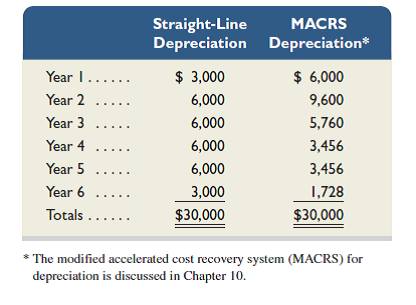
Required
1. Prepare a five-column table that reports amounts (assuming use of straight-line depreciation) for each of the following items for each of the six years: (a) pretax income before depreciation, (b) straight-line depreciation expense, (c) taxable income, (d) income taxes, and (e) net cash flow. Net cash flow equals the amount of income before depreciation minus the income taxes. (Round answers to the nearest dollar.)
2. Prepare a five-column table that reports amounts (assuming use of MACRS depreciation) for each of the following items for each of the six years: (a) pretax income before depreciation, (b) MACRS depreciation expense, (c) taxable income, (d) income taxes, and (e) net cash flow. Net cash flow equals the amount of income before depreciation minus the income taxes. (Round answers to the nearest dollar.)
3. Compute the net present value of the investment if straight-line depreciation is used. Use 10% as the discount rate. (Round the net present value to the nearest dollar.)
4. Compute the net present value of the investment if MACRS depreciation is used. Use 10% as the discount rate. (Round the net present value to the nearest dollar.)
Analysis Component
5. Explain why the MACRS depreciation method increases the net present value of this project.

Required
1. Prepare a five-column table that reports amounts (assuming use of straight-line depreciation) for each of the following items for each of the six years: (a) pretax income before depreciation, (b) straight-line depreciation expense, (c) taxable income, (d) income taxes, and (e) net cash flow. Net cash flow equals the amount of income before depreciation minus the income taxes. (Round answers to the nearest dollar.)
2. Prepare a five-column table that reports amounts (assuming use of MACRS depreciation) for each of the following items for each of the six years: (a) pretax income before depreciation, (b) MACRS depreciation expense, (c) taxable income, (d) income taxes, and (e) net cash flow. Net cash flow equals the amount of income before depreciation minus the income taxes. (Round answers to the nearest dollar.)
3. Compute the net present value of the investment if straight-line depreciation is used. Use 10% as the discount rate. (Round the net present value to the nearest dollar.)
4. Compute the net present value of the investment if MACRS depreciation is used. Use 10% as the discount rate. (Round the net present value to the nearest dollar.)
Analysis Component
5. Explain why the MACRS depreciation method increases the net present value of this project.

Unlock Deck
Unlock for access to all 91 flashcards in this deck.
Unlock Deck
k this deck
33
Refer to the information in Exercise 25-5. Assume the company requires a 10% rate of return on its investments. Compute the net present value of each potential investment. (Round to the nearest dollar.)
Reference: Exercise 25-5.
Compute the payback period for each of these two separate investments (round the payback period to two decimals):
a. A new operating system for an existing machine is expected to cost $520,000 and have a useful life of six years. The system yields an incremental after-tax income of $150,000 each year after deducting its straight-line depreciation. The predicted salvage value of the system is $10,000.
b. A machine costs $380,000, has a $20,000 salvage value, is expected to last eight years, and will generate an after-tax income of $60,000 per year after straight-line depreciation.
Reference: Exercise 25-5.
Compute the payback period for each of these two separate investments (round the payback period to two decimals):
a. A new operating system for an existing machine is expected to cost $520,000 and have a useful life of six years. The system yields an incremental after-tax income of $150,000 each year after deducting its straight-line depreciation. The predicted salvage value of the system is $10,000.
b. A machine costs $380,000, has a $20,000 salvage value, is expected to last eight years, and will generate an after-tax income of $60,000 per year after straight-line depreciation.

Unlock Deck
Unlock for access to all 91 flashcards in this deck.
Unlock Deck
k this deck
34
 Why does the use of the accelerated depreciation method (instead of straight-line) for income tax reporting increase an investment's value
Why does the use of the accelerated depreciation method (instead of straight-line) for income tax reporting increase an investment's value
Unlock Deck
Unlock for access to all 91 flashcards in this deck.
Unlock Deck
k this deck
35
Refer to the information in Exercise 25-10. Create an Excel spreadsheet to compute the internal rate of return for each of the projects. Round the percentage return to two decimals.
Reference: Exercise 25-10
Following is information on two alternative investments being considered by Jolee Company. The company requires a 10% return from its investments.
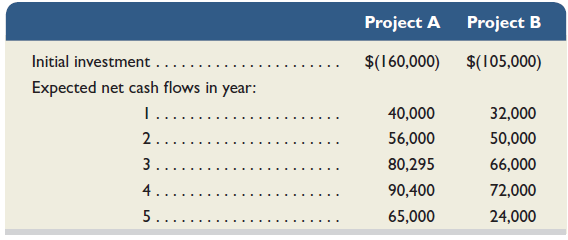
For each alternative project compute the (a) net present value, and (b) profitability index. (Round your answers in part b to two decimal places.) If the company can only select one project, which should it choose Explain.
Reference: Exercise 25-10
Following is information on two alternative investments being considered by Jolee Company. The company requires a 10% return from its investments.

For each alternative project compute the (a) net present value, and (b) profitability index. (Round your answers in part b to two decimal places.) If the company can only select one project, which should it choose Explain.

Unlock Deck
Unlock for access to all 91 flashcards in this deck.
Unlock Deck
k this deck
36
Cobe Company has already manufactured 28,000 units of Product A at a cost of $28 per unit. The 28,000 units can be sold at this stage for $700,000. Alternatively, the units can be further processed at a $420,000 total additional cost and be converted into 5,600 units of Product B and 11,200 units of Product C. Per unit selling price for Product B is $105 and for Product C is $70. Prepare an analysis that shows whether the 28,000 units of Product A should be processed further or not.

Unlock Deck
Unlock for access to all 91 flashcards in this deck.
Unlock Deck
k this deck
37
Capital budgeting decisions require careful analysis because they are generally the _______ ________ and __________ decisions that management faces.

Unlock Deck
Unlock for access to all 91 flashcards in this deck.
Unlock Deck
k this deck
38
Park Co. is considering an investment that requires immediate payment of $27,000 and provides expected cash inflows of $9,000 annually for four years. Assume Park Co. requires a 10% return on its investments. Based on its internal rate of return, should Park Co. make the investment

Unlock Deck
Unlock for access to all 91 flashcards in this deck.
Unlock Deck
k this deck
39
Elegant Decor Company's management is trying to decide whether to eliminate Department 200, which has produced losses or low profits for several years. The company's 2015 departmental income statements show the following.

In analyzing whether to eliminate Department 200, management considers the following:
a. The company has one office worker who earns $600 per week, or $31,200 per year, and four salesclerks who each earn $500 per week, or $26,000 per year for each salesclerk.
b. The full salaries of two salesclerks are charged to Department 100. The full salary of one salesclerk is charged to Department 200. The salary of the fourth clerk, who works half-time in both departments, is divided evenly between the two departments.
c. Eliminating Department 200 would avoid the sales salaries and the office salary currently allocated to it. However, management prefers another plan. Two salesclerks have indicated that they will be quitting soon. Management believes that their work can be done by the other two clerks if the one office worker works in sales half-time. Eliminating Department 200 will allow this shift of duties. If this change is implemented, half the office worker's salary would be reported as sales salaries and half would be reported as office salary.
d. The store building is rented under a long-term lease that cannot be changed. Therefore, Department 100 will use the space and equipment currently used by Department 200.
e. Closing Department 200 will eliminate its expenses for advertising, bad debts, and store supplies; 70% of the insurance expense allocated to it to cover its merchandise inventory; and 25% of the miscellaneous office expenses presently allocated to it.
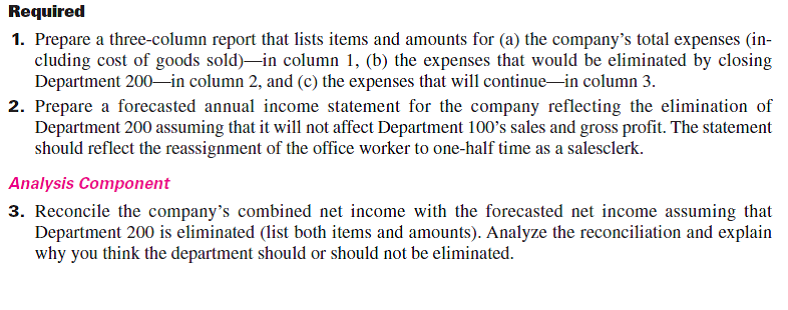

In analyzing whether to eliminate Department 200, management considers the following:
a. The company has one office worker who earns $600 per week, or $31,200 per year, and four salesclerks who each earn $500 per week, or $26,000 per year for each salesclerk.
b. The full salaries of two salesclerks are charged to Department 100. The full salary of one salesclerk is charged to Department 200. The salary of the fourth clerk, who works half-time in both departments, is divided evenly between the two departments.
c. Eliminating Department 200 would avoid the sales salaries and the office salary currently allocated to it. However, management prefers another plan. Two salesclerks have indicated that they will be quitting soon. Management believes that their work can be done by the other two clerks if the one office worker works in sales half-time. Eliminating Department 200 will allow this shift of duties. If this change is implemented, half the office worker's salary would be reported as sales salaries and half would be reported as office salary.
d. The store building is rented under a long-term lease that cannot be changed. Therefore, Department 100 will use the space and equipment currently used by Department 200.
e. Closing Department 200 will eliminate its expenses for advertising, bad debts, and store supplies; 70% of the insurance expense allocated to it to cover its merchandise inventory; and 25% of the miscellaneous office expenses presently allocated to it.


Unlock Deck
Unlock for access to all 91 flashcards in this deck.
Unlock Deck
k this deck
40
Following is information on two alternative investments being considered by Jolee Company. The company requires a 10% return from its investments.
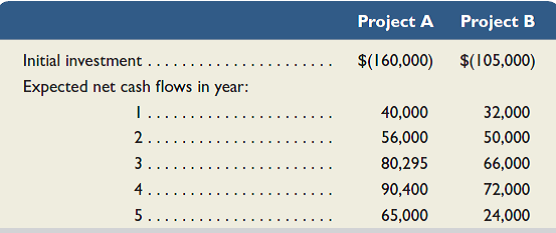
For each alternative project compute the (a) net present value, and (b) profitability index. (Round your answers in part b to two decimal places.) If the company can only select one project, which should it choose Explain.

For each alternative project compute the (a) net present value, and (b) profitability index. (Round your answers in part b to two decimal places.) If the company can only select one project, which should it choose Explain.

Unlock Deck
Unlock for access to all 91 flashcards in this deck.
Unlock Deck
k this deck
41
Label each of the following statements as either true ("T") or false ("F").
______ 1. Relevant costs are also known as unavoidable costs.
______ 2. Incremental costs are also known as differential costs.
______ 3. An out-of-pocket cost requires a current and/or future outlay of cash.
______ 4. An opportunity cost is the potential benefit that is lost by taking a specific action when two or more alternative choices are available.
______ 5. A sunk cost will change with a future course of action.
______ 1. Relevant costs are also known as unavoidable costs.
______ 2. Incremental costs are also known as differential costs.
______ 3. An out-of-pocket cost requires a current and/or future outlay of cash.
______ 4. An opportunity cost is the potential benefit that is lost by taking a specific action when two or more alternative choices are available.
______ 5. A sunk cost will change with a future course of action.

Unlock Deck
Unlock for access to all 91 flashcards in this deck.
Unlock Deck
k this deck
42
A guitar manufacturer is considering eliminating its electric guitar division because its $76,000 expenses are higher than its $72,000 sales. The company reports the following expenses for this division. Should the division be eliminated



Unlock Deck
Unlock for access to all 91 flashcards in this deck.
Unlock Deck
k this deck
43
Beyer Company is considering the purchase of an asset for $180,000. It is expected to produce the following net cash flows. The cash flows occur evenly throughout each year. Compute the payback period for this investment (round years to two decimals).



Unlock Deck
Unlock for access to all 91 flashcards in this deck.
Unlock Deck
k this deck
44
Payback period, accounting rate of return, net present value, and internal rate of return are common methods to evaluate capital investment opportunities. Assume that your manager asks you to identify the type of measurement basis and unit that each method offers and to list the advantages and disadvantages of each. Present your response in memorandum format of less than one page.

Unlock Deck
Unlock for access to all 91 flashcards in this deck.
Unlock Deck
k this deck
45
Esme Company's management is trying to decide whether to eliminate Department Z, which has produced low profits or losses for several years. The company's 2015 departmental income statements show the following.

In analyzing whether to eliminate Department Z, management considers the following items:
a. The company has one office worker who earns $500 per week or $26,000 per year and four salesclerks who each earn $450 per week or $23,400 per year for each salesclerk.
b. The full salaries of three salesclerks are charged to Department A. The full salary of one salesclerk is charged to Department Z.
c. Eliminating Department Z would avoid the sales salaries and the office salary currently allocated to it. However, management prefers another plan. Two salesclerks have indicated that they will be quitting soon. Management believes that their work can be done by the two remaining clerks if the one office worker works in sales half-time. Eliminating Department Z will allow this shift of duties. If this change is implemented, half the office worker's salary would be reported as sales salaries and half would be reported as office salary.
d. The store building is rented under a long-term lease that cannot be changed. Therefore, Department A will use the space and equipment currently used by Department Z.
e. Closing Department Z will eliminate its expenses for advertising, bad debts, and store supplies; 65%
of the insurance expense allocated to it to cover its merchandise inventory; and 30% of the miscellaneous office expenses presently allocated to it.
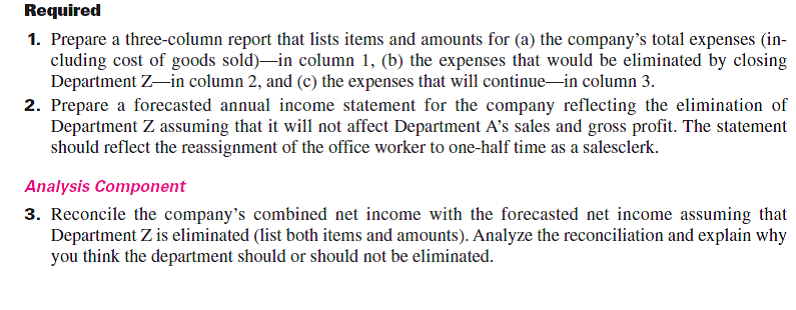

In analyzing whether to eliminate Department Z, management considers the following items:
a. The company has one office worker who earns $500 per week or $26,000 per year and four salesclerks who each earn $450 per week or $23,400 per year for each salesclerk.
b. The full salaries of three salesclerks are charged to Department A. The full salary of one salesclerk is charged to Department Z.
c. Eliminating Department Z would avoid the sales salaries and the office salary currently allocated to it. However, management prefers another plan. Two salesclerks have indicated that they will be quitting soon. Management believes that their work can be done by the two remaining clerks if the one office worker works in sales half-time. Eliminating Department Z will allow this shift of duties. If this change is implemented, half the office worker's salary would be reported as sales salaries and half would be reported as office salary.
d. The store building is rented under a long-term lease that cannot be changed. Therefore, Department A will use the space and equipment currently used by Department Z.
e. Closing Department Z will eliminate its expenses for advertising, bad debts, and store supplies; 65%
of the insurance expense allocated to it to cover its merchandise inventory; and 30% of the miscellaneous office expenses presently allocated to it.


Unlock Deck
Unlock for access to all 91 flashcards in this deck.
Unlock Deck
k this deck
46
Yokam Company is considering two alternative projects. Project 1 requires an initial investment of $400,000 and has a present value of cash flows of $1,100,000. Project 2 requires an initial investment of $4 million and has a present value of cash flows of $6 million. Compute the profitability index for each project. Based on the profitability index, which project should the company prefer Explain.

Unlock Deck
Unlock for access to all 91 flashcards in this deck.
Unlock Deck
k this deck
47
Fill in each of the blanks below with the correct term.
1. A ________ arises from a past decision and cannot be avoided or changed; it is irrelevant to future decisions.
2. ________ refer to the incremental revenue generated from taking one particular action over another.
3. Relevant costs are also known as ________.
4. An________ requires a future outlay of cash and is relevant for current and future decision making.
5. An ________ is the potential benefit lost by taking a specific action when two or more alternative choices are available.
1. A ________ arises from a past decision and cannot be avoided or changed; it is irrelevant to future decisions.
2. ________ refer to the incremental revenue generated from taking one particular action over another.
3. Relevant costs are also known as ________.
4. An________ requires a future outlay of cash and is relevant for current and future decision making.
5. An ________ is the potential benefit lost by taking a specific action when two or more alternative choices are available.

Unlock Deck
Unlock for access to all 91 flashcards in this deck.
Unlock Deck
k this deck
48
Colt Company owns a machine that can produce two specialized products. Production time for Product TLX is two units per hour and for Product MTV is five units per hour. The machine's capacity is 2,750 hours per year. Both products are sold to a single customer who has agreed to buy all of the company's output up to a maximum of 4,700 units of Product TLX and 2,500 units of Product MTV. Selling prices and variable costs per unit to produce the products follow. Determine (1) the company's most profitable sales mix and (2) the contribution margin that results from that sales mix.



Unlock Deck
Unlock for access to all 91 flashcards in this deck.
Unlock Deck
k this deck
49
Factor Company is planning to add a new product to its line. To manufacture this product, the company needs to buy a new machine at a $480,000 cost with an expected four-year life and a $20,000 salvage value. All sales are for cash, and all costs are out-of-pocket, except for depreciation on the new machine. Additional information includes the following.

Required
1. Compute straight-line depreciation for each year of this new machine's life. (Round depreciation amounts to the nearest dollar.)
2. Determine expected net income and net cash flow for each year of this machine's life. (Round answers to the nearest dollar.)
3. Compute this machine's payback period, assuming that cash flows occur evenly throughout each year. (Round the payback period to two decimals.)
4. Compute this machine's accounting rate of return, assuming that income is earned evenly throughout each year. (Round the percentage return to two decimals.)
5. Compute the net present value for this machine using a discount rate of 7% and assuming that cash flows occur at each year-end. ( Hint: Salvage value is a cash inflow at the end of the asset's life. Round the net present value to the nearest dollar.)

Required
1. Compute straight-line depreciation for each year of this new machine's life. (Round depreciation amounts to the nearest dollar.)
2. Determine expected net income and net cash flow for each year of this machine's life. (Round answers to the nearest dollar.)
3. Compute this machine's payback period, assuming that cash flows occur evenly throughout each year. (Round the payback period to two decimals.)
4. Compute this machine's accounting rate of return, assuming that income is earned evenly throughout each year. (Round the percentage return to two decimals.)
5. Compute the net present value for this machine using a discount rate of 7% and assuming that cash flows occur at each year-end. ( Hint: Salvage value is a cash inflow at the end of the asset's life. Round the net present value to the nearest dollar.)

Unlock Deck
Unlock for access to all 91 flashcards in this deck.
Unlock Deck
k this deck
50
Identify two disadvantages of using the payback period for comparing investments.

Unlock Deck
Unlock for access to all 91 flashcards in this deck.
Unlock Deck
k this deck
51
Project A requires a $280,000 initial investment for new machinery with a five-year life and a salvage value of $30,000. The company uses straight-line depreciation. Project A is expected to yield annual net income of $20,000 per year for the next five years. Compute Project A's accounting rate of return. Express your answer as a percentage, rounded to two decimal places.

Unlock Deck
Unlock for access to all 91 flashcards in this deck.
Unlock Deck
k this deck
52
Google has many types of costs. What is an out-of-pocket cost What is an opportunity cost Are opportunity costs recorded in the accounting records



Unlock Deck
Unlock for access to all 91 flashcards in this deck.
Unlock Deck
k this deck
53
Radar Company sells bikes for $300 each. The company currently sells 3,750 bikes per year and could make as many as 5,000 bikes per year. The bikes cost $225 each to make; $150 in variable costs per bike and $75 of fixed costs per bike. Radar received an offer from a potential customer who wants to buy 750 bikes for $250 each. Incremental fixed costs to make this order are $50,000. No other costs will change if this order is accepted. Compute Radar's additional income (ignore taxes) if it accepts this order.

Unlock Deck
Unlock for access to all 91 flashcards in this deck.
Unlock Deck
k this deck
54
A division of a large company reports the information shown below for a recent year. Variable costs and direct fixed costs are avoidable, and 40% of the indirect fixed costs are avoidable. Based on this information, should the division be eliminated



Unlock Deck
Unlock for access to all 91 flashcards in this deck.
Unlock Deck
k this deck
55
Cortino Company is planning to add a new product to its line. To manufacture this product, the company needs to buy a new machine at a $300,000 cost with an expected four-year life and a $20,000 salvage value. All sales are for cash and all costs are out-of-pocket, except for depreciation on the new machine. Additional information includes the following.

Required
1. Compute straight-line depreciation for each year of this new machine's life. (Round depreciation amounts to the nearest dollar.)
2. Determine expected net income and net cash flow for each year of this machine's life. (Round answers to the nearest dollar.)
3. Compute this machine's payback period, assuming that cash flows occur evenly throughout each year. (Round the payback period to two decimals.)
4. Compute this machine's accounting rate of return, assuming that income is earned evenly throughout each year. (Round the percentage return to two decimals.)
5. Compute the net present value for this machine using a discount rate of 7% and assuming that cash flows occur at each year-end. ( Hint: Salvage value is a cash inflow at the end of the asset's life.)

Required
1. Compute straight-line depreciation for each year of this new machine's life. (Round depreciation amounts to the nearest dollar.)
2. Determine expected net income and net cash flow for each year of this machine's life. (Round answers to the nearest dollar.)
3. Compute this machine's payback period, assuming that cash flows occur evenly throughout each year. (Round the payback period to two decimals.)
4. Compute this machine's accounting rate of return, assuming that income is earned evenly throughout each year. (Round the percentage return to two decimals.)
5. Compute the net present value for this machine using a discount rate of 7% and assuming that cash flows occur at each year-end. ( Hint: Salvage value is a cash inflow at the end of the asset's life.)

Unlock Deck
Unlock for access to all 91 flashcards in this deck.
Unlock Deck
k this deck
56
Refer to the information in Exercise 25-3 and assume instead that double-declining depreciation is applied. Compute the machine's payback period (ignore taxes). (Round the payback period to three decimals.)
Reference: Exercise 25-3
A machine can be purchased for $150,000 and used for five years, yielding the following net incomes. In projecting net incomes, straight-line depreciation is applied, using a five-year life and a zero salvage value. Compute the machine's payback period (ignore taxes). (Round the payback period to three decimals.)

Reference: Exercise 25-3
A machine can be purchased for $150,000 and used for five years, yielding the following net incomes. In projecting net incomes, straight-line depreciation is applied, using a five-year life and a zero salvage value. Compute the machine's payback period (ignore taxes). (Round the payback period to three decimals.)


Unlock Deck
Unlock for access to all 91 flashcards in this deck.
Unlock Deck
k this deck
57
Read the chapter opener about Limor Fried and her company, Adafruit Industries. Suppose Limor's business continues to grow, and she builds a massive new manufacturing facility and warehousing center to make her business more efficient and reduce costs.
Required
1. What are some of the management tools that Limor can use to evaluate whether the new manufacturing facility and warehousing center will be a good investment
2. What information does Limor need to use the tools that you identified in your answer to part 1
3. What are some of the advantages and disadvantages of each tool identified in your answer to part 1
Required
1. What are some of the management tools that Limor can use to evaluate whether the new manufacturing facility and warehousing center will be a good investment
2. What information does Limor need to use the tools that you identified in your answer to part 1
3. What are some of the advantages and disadvantages of each tool identified in your answer to part 1

Unlock Deck
Unlock for access to all 91 flashcards in this deck.
Unlock Deck
k this deck
58
Following is information on two alternative investments being considered by Tiger Co. The company requires a 4% return from its investments.

Compute each project's (a) net present value and (b) profitability index. (Round present value calculations to the nearest dollar and round the profitability index to two decimal places.) If the company can choose only one project, which should it choose Explain.

Compute each project's (a) net present value and (b) profitability index. (Round present value calculations to the nearest dollar and round the profitability index to two decimal places.) If the company can choose only one project, which should it choose Explain.

Unlock Deck
Unlock for access to all 91 flashcards in this deck.
Unlock Deck
k this deck
59
Farrow Co. expects to sell 150,000 units of its product in the next period with the following results.

The company has an opportunity to sell 15,000 additional units at $12 per unit. The additional sales would not affect its current expected sales. Direct materials and labor costs per unit would be the same for the additional units as they are for the regular units. However, the additional volume would create the following incremental costs: (1) total overhead would increase by 15% and (2) administrative expenses would increase by $64,500. Prepare an analysis to determine whether the company should accept or reject the offer to sell additional units at the reduced price of $12 per unit.

The company has an opportunity to sell 15,000 additional units at $12 per unit. The additional sales would not affect its current expected sales. Direct materials and labor costs per unit would be the same for the additional units as they are for the regular units. However, the additional volume would create the following incremental costs: (1) total overhead would increase by 15% and (2) administrative expenses would increase by $64,500. Prepare an analysis to determine whether the company should accept or reject the offer to sell additional units at the reduced price of $12 per unit.

Unlock Deck
Unlock for access to all 91 flashcards in this deck.
Unlock Deck
k this deck
60
Suresh Co. expects its five departments to yield the following income for next year.

Recompute and prepare the departmental income statements (including a combined total column) for the company under each of the following separate scenarios: Management (1) eliminates departments with expected net losses, and (2) eliminates departments with sales dollars that are less than avoidable expenses. Explain your answers to parts 1 and 2.

Recompute and prepare the departmental income statements (including a combined total column) for the company under each of the following separate scenarios: Management (1) eliminates departments with expected net losses, and (2) eliminates departments with sales dollars that are less than avoidable expenses. Explain your answers to parts 1 and 2.

Unlock Deck
Unlock for access to all 91 flashcards in this deck.
Unlock Deck
k this deck
61
Park Co. is considering an investment that requires immediate payment of $27,000 and provides expected cash inflows of $9,000 annually for four years. What is the investment's payback period

Unlock Deck
Unlock for access to all 91 flashcards in this deck.
Unlock Deck
k this deck
62
Jones Products manufactures and sells to wholesalers approximately 400,000 packages per year of underwater markers at $6 per package. Annual costs for the production and sale of this quantity are shown in the table.

A new wholesaler has offered to buy 50,000 packages for $5.20 each. These markers would be marketed under the wholesaler's name and would not affect Jones Products's sales through its normal channels. A study of the costs of this additional business reveals the following:

Required
Prepare a three-column comparative income statement that shows the following:
1. Annual operating income without the special order (column 1).
2. Annual operating income received from the new business only (column 2).
3. Combined annual operating income from normal business and the new business (column 3).

A new wholesaler has offered to buy 50,000 packages for $5.20 each. These markers would be marketed under the wholesaler's name and would not affect Jones Products's sales through its normal channels. A study of the costs of this additional business reveals the following:

Required
Prepare a three-column comparative income statement that shows the following:
1. Annual operating income without the special order (column 1).
2. Annual operating income received from the new business only (column 2).
3. Combined annual operating income from normal business and the new business (column 3).

Unlock Deck
Unlock for access to all 91 flashcards in this deck.
Unlock Deck
k this deck
63
If the present value of the expected net cash flows from a machine, discounted at 10%, exceeds the amount to be invested, what can you say about the investment's expected rate of return What can you say about the expected rate of return if the present value of the net cash flows, discounted at 10%, is less than the investment amount

Unlock Deck
Unlock for access to all 91 flashcards in this deck.
Unlock Deck
k this deck
64
Following is information on an investment considered by Hudson Co. The investment has zero salvage value. The company requires a 12% return from its investments. Compute this investment's net present value.



Unlock Deck
Unlock for access to all 91 flashcards in this deck.
Unlock Deck
k this deck
65
Kando Company incurs a $9 per unit cost for Product A, which it currently manufactures and sells for $13.50 per unit. Instead of manufacturing and selling this product, the company can purchase Product B for $5 per unit and sell it for $12 per unit. If it does so, unit sales would remain unchanged and $5 of the $9 per unit costs assigned to Product A would be eliminated. Should the company continue to manufacture Product A or purchase Product B for resale

Unlock Deck
Unlock for access to all 91 flashcards in this deck.
Unlock Deck
k this deck
66
Rory Company has a machine with a book value of $75,000 and a remaining five-year useful life. A new machine is available at a cost of $112,500, and Rory can also receive $60,000 for trading in its old machine. The new machine will reduce variable manufacturing costs by $13,000 per year over its five-year useful life. Should the machine be replaced

Unlock Deck
Unlock for access to all 91 flashcards in this deck.
Unlock Deck
k this deck
67
(This serial problem began in Chapter 1 and continues through most of the book. If previous chapter segments were not completed, the serial problem can begin at this point. It is helpful, but not necessary, to use the Working Papers that accompany the book.)
Santana Rey is considering the purchase of equipment for Business Solutions that would allow the company to add a new product to its computer furniture line. The equipment is expected to cost $300,000 and to have a six-year life and no salvage value. It will be depreciated on a straight-line basis. Business Solutions expects to sell 100 units of the equipment's product each year. The expected annual income related to this equipment follows.
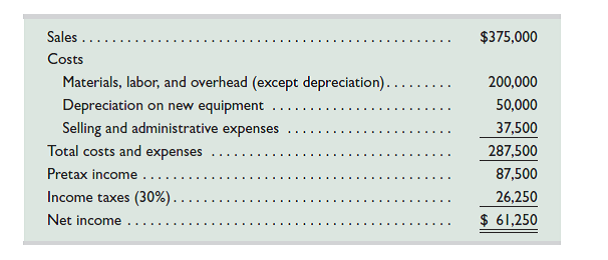
Required
Compute the (1) payback period and (2) accounting rate of return for this equipment. (Record answers as percents, rounded to one decimal.)
Santana Rey is considering the purchase of equipment for Business Solutions that would allow the company to add a new product to its computer furniture line. The equipment is expected to cost $300,000 and to have a six-year life and no salvage value. It will be depreciated on a straight-line basis. Business Solutions expects to sell 100 units of the equipment's product each year. The expected annual income related to this equipment follows.

Required
Compute the (1) payback period and (2) accounting rate of return for this equipment. (Record answers as percents, rounded to one decimal.)

Unlock Deck
Unlock for access to all 91 flashcards in this deck.
Unlock Deck
k this deck
68
Windmire Company manufactures and sells to local wholesalers approximately 300,000 units per month at a sales price of $4 per unit. Monthly costs for the production and sale of this quantity follow.

Required
Prepare a three-column comparative income statement that shows the following:
1. Monthly operating income without the special order (column 1).
2. Monthly operating income received from the new business only (column 2).
3. Combined monthly operating income from normal business and the new business (column 3).

Required
Prepare a three-column comparative income statement that shows the following:
1. Monthly operating income without the special order (column 1).
2. Monthly operating income received from the new business only (column 2).
3. Combined monthly operating income from normal business and the new business (column 3).

Unlock Deck
Unlock for access to all 91 flashcards in this deck.
Unlock Deck
k this deck
69
A machine costs $700,000 and is expected to yield an after-tax net income of $52,000 each year. Management predicts this machine has a 10-year service life and a $100,000 salvage value, and it uses straight-line depreciation. Compute this machine's accounting rate of return.

Unlock Deck
Unlock for access to all 91 flashcards in this deck.
Unlock Deck
k this deck
70
 Samsung must confront sunk costs. Why are sunk costs irrelevant in deciding whether to sell a product in its present condition or to make it into a new product through additional processing
Samsung must confront sunk costs. Why are sunk costs irrelevant in deciding whether to sell a product in its present condition or to make it into a new product through additional processing 

Unlock Deck
Unlock for access to all 91 flashcards in this deck.
Unlock Deck
k this deck
71
Goshford Company produces a single product and has capacity to produce 100,000 units per month. Costs to produce its current sales of 80,000 units follow. The regular selling price of the product is $100 per unit. Management is approached by a new customer who wants to purchase 20,000 units of the product for $75 per unit. If the order is accepted, there will be no additional fixed manufacturing overhead, and no additional fixed selling and administrative expenses. The customer is not in the company's regular selling territory, so there will be a $5 per unit shipping expense in addition to the regular variable selling and administrative expenses.
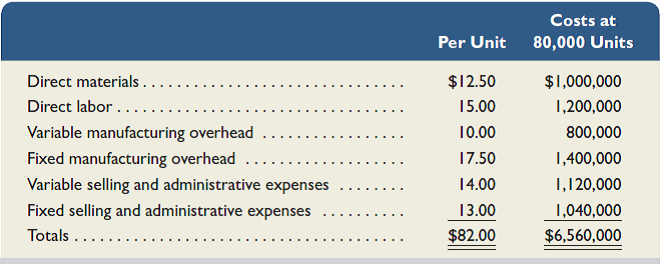
1. Determine whether management should accept or reject the new business.
2. What nonfinancial factors should management consider when deciding whether to take this order

1. Determine whether management should accept or reject the new business.
2. What nonfinancial factors should management consider when deciding whether to take this order

Unlock Deck
Unlock for access to all 91 flashcards in this deck.
Unlock Deck
k this deck
72
Xinhong Company is considering replacing one of its manufacturing machines. The machine has a book value of $45,000 and a remaining useful life of 5 years, at which time its salvage value will be zero. It has a current market value of $52,000. Variable manufacturing costs are $36,000 per year for this machine. Information on two alternative replacement machines follows. Should Xinhong keep or replace its manufacturing machine If the machine should be replaced, which alternative new machine should Xinhong purchase



Unlock Deck
Unlock for access to all 91 flashcards in this deck.
Unlock Deck
k this deck
73
Apple and Google sell a variety of products, including smartphones and tablet computers. Some products are more profitable than others. Teams of employees in each company make advertising, investment, and product mix decisions. A certain portion of advertising for both companies is on a local basis to a target audience.
Required
1. Contact the local newspaper and ask the approximate cost of ad space (for example, cost of one page or one-half page of advertising) for a company's product or group of products (such as Apple iPads).
2. Estimate how many products this advertisement must sell to justify its cost. Begin by taking the product's sales price advertised for each company and assume a 20% contribution margin.
3. Prepare a half-page memorandum explaining the importance of effective advertising when making a product mix decision. Be prepared to present your ideas in class.
Required
1. Contact the local newspaper and ask the approximate cost of ad space (for example, cost of one page or one-half page of advertising) for a company's product or group of products (such as Apple iPads).
2. Estimate how many products this advertisement must sell to justify its cost. Begin by taking the product's sales price advertised for each company and assume a 20% contribution margin.
3. Prepare a half-page memorandum explaining the importance of effective advertising when making a product mix decision. Be prepared to present your ideas in class.

Unlock Deck
Unlock for access to all 91 flashcards in this deck.
Unlock Deck
k this deck
74
Howard Co. is considering two alternative investments. The payback period is 3.5 years for Investment A and 4 years for Investment B. (1) If management relies on the payback period, which investment is preferred (2) Why might Howard's analysis of these two alternatives lead to the selection of B over A

Unlock Deck
Unlock for access to all 91 flashcards in this deck.
Unlock Deck
k this deck
75
Peng Company is considering an investment expected to generate an average net income after taxes of $1,950 for three years. The investment costs $45,000 and has an estimated $6,000 salvage value. Compute the accounting rate of return for this investment; assume the company uses straight-line depreciation. Express your answer as a percentage, rounded to two decimal places.

Unlock Deck
Unlock for access to all 91 flashcards in this deck.
Unlock Deck
k this deck
76
Refer to the information in Exercise 25-11 and instead assume the company requires a 12% return on its investments. Compute each project's (a) net present value and (b) profitability index. (Round present value calculations to the nearest dollar.) Express the profitability index as a percentage (rounded to two decimal places). If the company can choose only one project, which should it choose Explain.
Reference: Exercise 25-11
Following is information on two alternative investments being considered by Tiger Co. The company requires a 4% return from its investments.

Compute each project's (a) net present value and (b) profitability index. (Round present value calculations to the nearest dollar and round the profitability index to two decimal places.) If the company can choose only one project, which should it choose Explain.
Reference: Exercise 25-11
Following is information on two alternative investments being considered by Tiger Co. The company requires a 4% return from its investments.

Compute each project's (a) net present value and (b) profitability index. (Round present value calculations to the nearest dollar and round the profitability index to two decimal places.) If the company can choose only one project, which should it choose Explain.

Unlock Deck
Unlock for access to all 91 flashcards in this deck.
Unlock Deck
k this deck
77
Xia Co. currently buys a component part for $5 per unit. Xia believes that making the part would require $2.25 per unit of direct materials and $1.00 per unit of direct labor. Xia allocates overhead using a predetermined overhead rate of 200% of direct labor cost. Xia estimates an incremental overhead rate of $0.75 per unit to make the part. Should Xia make or buy the part

Unlock Deck
Unlock for access to all 91 flashcards in this deck.
Unlock Deck
k this deck
78
Heels, a shoe manufacturer, is evaluating the costs and benefits of new equipment that would custom fit each pair of athletic shoes. The customer would have his or her foot scanned by digital computer equipment; this information would be used to cut the raw materials to provide the customer a perfect fit. The new equipment costs $90,000 and is expected to generate an additional $35,000 in cash flows for five years. A bank will make a $90,000 loan to the company at a 10% interest rate for this equipment's purchase. Use the following table to determine the break-even time for this equipment. (Round the present value of cash flows to the nearest dollar.)
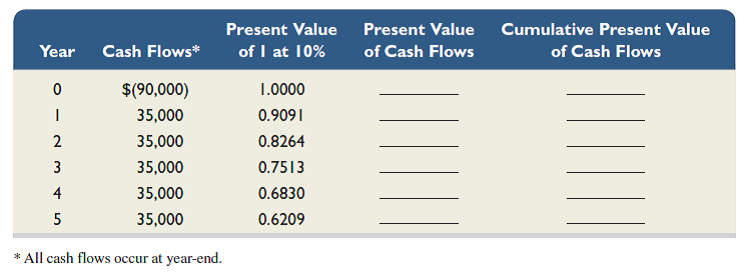


Unlock Deck
Unlock for access to all 91 flashcards in this deck.
Unlock Deck
k this deck
79
What is capital budgeting

Unlock Deck
Unlock for access to all 91 flashcards in this deck.
Unlock Deck
k this deck
80
Many companies must determine whether to internally produce their component parts or to outsource them. Further, some companies now outsource key components or business processes to international providers. Access the website sourcingmag.com and review the available information on business process outsourcing. (click on "What is BPO ")
Required
1. According to this website, what is business process outsourcing
2. What types of processes are commonly outsourced, according to this website
3. What are some of the benefits of business process outsourcing
Required
1. According to this website, what is business process outsourcing
2. What types of processes are commonly outsourced, according to this website
3. What are some of the benefits of business process outsourcing

Unlock Deck
Unlock for access to all 91 flashcards in this deck.
Unlock Deck
k this deck



